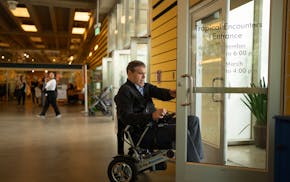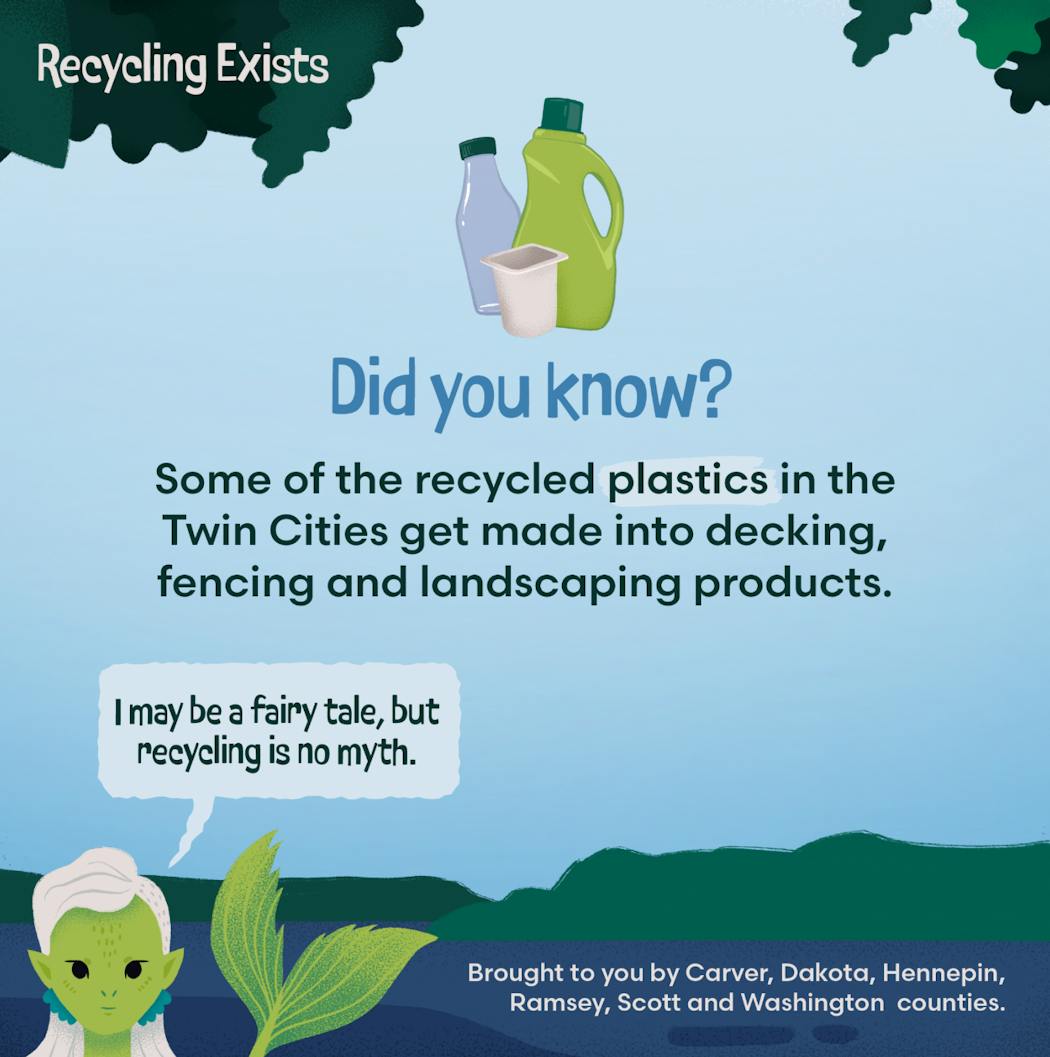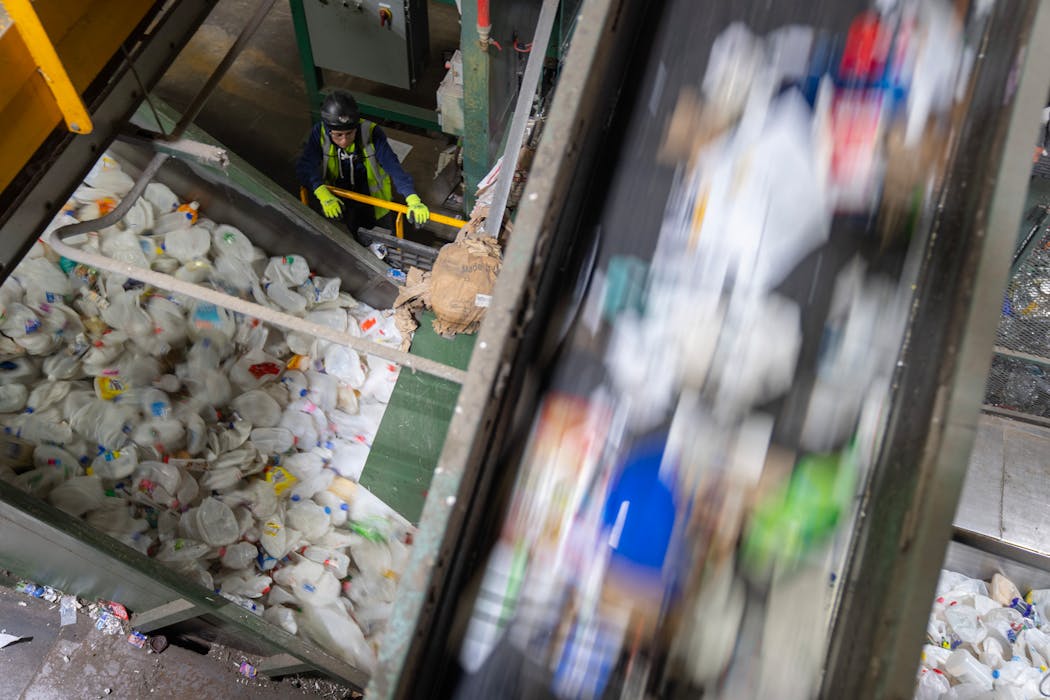A plastic milk jug gets tossed into the recycling bin. But does it actually end up in a landfill?
Not in Minnesota, as mythical stars in a new advertising campaign will tell you: Everything recyclable in Minnesota bins actually gets recycled.
Six metro area counties launched the whimsical campaign, which features a dragon, a mermaid and a unicorn, to set straight a widespread misunderstanding that local recyclables, especially plastic, go to the dump.
"We here at Ramsey County have just been getting an increase in questions along the lines of, 'Is it worth it? ... Does recycling actually work? Does it make a difference?'" said Andrea McKennan, outreach and engagement supervisor with Ramsey County Environmental Health. Other counties were hearing the same, "so a number of counties came together to create this campaign to give a resounding 'yes' to those questions," she said.
The campaign launched last month, called Recycling Exists, is a collaboration between Carver, Dakota, Hennepin, Ramsey, Scott and Washington counties, and makes the case that while these mythical creatures don't exist, recycling in Minnesota does.
Recycling myths, busted
Misconceptions about recycling arise because it's not a simple system. That's especially the case when it comes to plastics, said Kaitlin Keller, waste reduction and recycling specialist for Hennepin County Environment and Energy.
"There's so many different types of plastic," she said. "They come in these random numbers, and [people] don't know what they mean. And they come in all these different shapes, and some of the plastic is hard, and some is like a plastic bag. It's a really confusing landscape for people."
Minnesota actually has laws that prohibit recyclables that have been put in recycling from going to the landfill, said Wayne Gjerde, recycling market development coordinator for the Minnesota Pollution Control Agency. "It can't go to a landfill. It can't go to a waste energy facility. It has to go to a recycling facility."
Recycling facilities have to submit reports to the state that outline where materials go and how much wasn't sold to companies that recycle it — the stuff people put in recycling bins that wasn't recyclable in the first place, said Miriam Holsinger, co-president of Eureka Recycling in Minneapolis.
Another misconception is that the recycling Minnesotans put in their bin is ending up far, far away.
Take, for example, photos and videos of beaches abroad full of plastic trash. It's a heartbreaking and very real problem, Holsinger said, but "what you're not seeing there is all the plastics that did successfully get recycled."
While some recycling from the U.S. coasts may be put in a shipping container and sent abroad, that would be expensive to do with many materials in Minnesota, said Michael Gunderson, the general manager at WestRock, which makes recycled paper products, like cereal boxes, near the Minneapolis-St. Paul border. The issue isn't ocean freight, which is relatively cheap, so much as truck freight. "It would cost more money for us to ship waste paper from the Twin Cities to a port in say, California, than it would to ship it from California to China," he said.
A local system
In Minnesota, the recycling industry is actually quite local. In 2022, Holsinger said, 74% of the recycling Eureka processed was sold for reuse in Minnesota, and 94% stayed in the Midwest.
What's all that recycling turning into?
McKennan listed some examples (more can be found on the ad campaign's website, recyclingexists.com):
- Many plastic containers — think plastic bottles, peanut butter jars and produce containers — are going to manufacturers in Idaho, Ohio and Wisconsin to be made into new bottles, McKennan said.
- Milk and laundry detergent jugs and shampoo bottles get made into outdoor products like plastic lawn furniture, playground equipment and decking in Minnesota.
- Many yogurt, cottage cheese and margarine tubs go to Ohio to be made into food containers and to Missouri to be made into auto parts.
- Paper and cardboard become new paper products.
- A lot of glass is sent to Shakopee to make new bottles.
- Metal cans are sent to places in Minnesota and the Midwest to be made into wire, beams and auto and appliance parts.
Many things that aren't accepted in curbside recycling bins, like plastic bags and electronics, can be recycled elsewhere. County websites are a good resource for finding out how to recycle specific goods.
The campaign is putting ads totaling $77,000 on social media, streaming services and Spanish language TV. Developed by Minneapolis ad agency Metre, it has gotten good reception so far, Keller said. "We're trying to make it be something that's approachable and easy to understand and covering the basics of recycling so people feel like they can take that action," she said.
Gjerde urged Minnesotans to have confidence that if they're recycling things that are recyclable, they're being put to good use. And to remember that it's not just good for the environment, but also good for the economy. In Minnesota, recycling supports about 78,000 jobs, he said.
"If you put something in a landfill, what does it do? It just sits there forever, and it has no economic value," he said. "If you put it back out there, it becomes part of the circular economy [and] becomes something again."
Anderson: For opener, fishing will be fantastic — and catching will be great

As unsolved Minneapolis homicides stack up, families of victims wait for answers

Minneapolis residential property taxes could rise steeply in 2025

'I'm a living miracle.' Tommies athlete goes from broken bones to broken record




